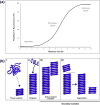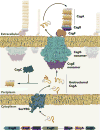Amyloid by Design: Intrinsic Regulation of Microbial Amyloid Assembly
- PMID: 30017921
- PMCID: PMC6168361
- DOI: 10.1016/j.jmb.2018.07.007
Amyloid by Design: Intrinsic Regulation of Microbial Amyloid Assembly
Abstract
The term amyloid has historically been used to describe fibrillar aggregates formed as the result of protein misfolding and that are associated with a range of diseases broadly termed amyloidoses. The discovery of "functional amyloids" expanded the amyloid umbrella to encompass aggregates structurally similar to disease-associated amyloids but that engage in a variety of biologically useful tasks without incurring toxicity. The mechanisms by which functional amyloid systems ensure nontoxic assembly has provided insights into potential therapeutic strategies for treating amyloidoses. Some of the most-studied functional amyloids are ones produced by bacteria. Curli amyloids are extracellular fibers made by enteric bacteria that function to encase and protect bacterial communities during biofilm formation. Here we review recent studies highlighting microbial functional amyloid assembly systems that are tailored to enable the assembly of non-toxic amyloid aggregates.
Keywords: functional amyloid; microbial amyloids; nature-inspired therapeutics; protein misfolding; toxic oligomer.
Copyright © 2018 Elsevier Ltd. All rights reserved.
Conflict of interest statement
Declarations of interest: none
Figures



References
-
- Chiti F, Dobson CM. Protein misfolding, functional amyloid, and human disease. Annu Rev Biochem. 2006;75:333–366. - PubMed
-
- Claessen D, Rink R, de Jong W, Siebring J, de Vreugd P, Boersma FG, Dijkhuizen L, Wosten HA. A novel class of secreted hydrophobic proteins is involved in aerial hyphae formation in Streptomyces coelicolor by forming amyloid-like fibrils. Genes Dev. 2003;17:1714–26. doi: 10.1101/gad.264303. - DOI - PMC - PubMed
Publication types
MeSH terms
Substances
Grants and funding
LinkOut - more resources
Full Text Sources
Other Literature Sources

